I met my reading goal of a book each week this year as well, thanks mainly to Terry Pratchett’s punny Discworld books. I had been putting them off for a couple of decades, so 2020 was the year it had to happen. I also managed to write an actual article after many many years, and hope I’ll be able to write some more in 2021.
Year: 2020
Résumé Rejection Reasons – An Illustrated Guide – Part 5 – Parting Tips

Part 5 – Parting Tips
A few remaining aspects of résumé creation and submission that did not fit in the previous parts…
Do Not Apply Everywhere
The ‘Careers’ section of a large firm’s website list dozens of job openings at any given time, as it is hiring perpetually. Do not follow the urge of applying to all of those positions, hoping to getting an interview. You’ll only hurt your chances of being shortlisted, if the firm is using a decent ATS, as your multiple résumé submissions will be aggregated and visible to the recruiter. If the openings that you are applying for require completely different skill-sets than your entry level résumé contains, your résumé could be ignored by the same recruiter when a matching position does open up, because of that first impression.
You do miss 100% of the shots that you don’t take, but you don’t jump into a basketball court with a hockey stick either.
 |
| This candidate ‘cracked’ the multiple applications restrictions by using different spelling combinations of their name. |
Targeted Résumé
If you have the will, time and motivation to customize your generic résumé to highlight the skills that are listed a particular the job description, do invest that time, without stretching the truth, and tweak your résumé. Using the same adjectives and technologies that are mentioned in the job ad is a good start, rearranging your résumé content so the expected attributes are highlighted is even better.
The time that you invest in creating a bespoke résumé would be worth it if it can make the recruiter believe that you are just the right person for the job. Do not stick to a generic résumé that you submit for twenty different openings.
You can further strengthen your application by linking your skills in the cover letter with the job description, through mentioning demonstrable experience and exposure.
Submission Filters
Some job ads have very specific instruction that are to be followed during résumé submission. Read those instructions, read them again, and then follow them precisely. Whether the ad calls for you to submit your résumé in .docx format, to use a specific subject line, or to include certain information at the end of your résumé, do exactly what is asked.
I must confess that I also use such filters to save my time, and I am surprised at the lack of compliance. Even when the job ad explicitly mentions that ‘Résumés that do not follow these instructions will not be considered.’, 90% of the applicants refuse to follow the provided instructions, and are not considered.
You can easily be in the top 10% of candidates who are filtered in, simply by doing what is asked.
ATS Friendliness
Even if your résumé is not the best fit for the job that you applied for, it might still be added to the résumé pool that most large firms maintain, so that it may be reconsidered for future openings.
There is always a shortage of high-quality candidates and an abundance of positions to fill, and don’t let anyone else make you think otherwise.
If your résumé lands in a résumé pool, but it is full of graphics and icons and everything but parsable text, it would most likely drown and would not be usable for other openings if the ATS is unable to properly parse it.
Make sure that your pdf résumé was created from text and not from a mosaic of images created in Photoshop, and also ensure that your skills and technology stack expertise are properly spelled and indexable. One quick test to see ATS friendliness is to save your pdf content as text, if the exported text maintains content some of the structure, the ATS will be happy.
Kaizen
Kaizen is about constant improvement, and is a great philosophy to apply on your résumé until you land a job, and even beyond that, to keep it current. Every day, keep pruning, improving, refining, editing and enhancing your résumé, even if it is one word or one bullet-point, so each future submission shows a better version of your résumé to the world.
Closing Thoughts
This post has evolved into a slightly lengthier version of the couple of pages that I intended to write on the dos and don’ts of résumé writing, mainly to help the fresh graduates out in their first job search. Therefore, whatever you have read above is my personal take and should not be taken as unbreakable rules.
The example images are taken from real résumé submission, to highlight the pitfalls to avoid while creating an entry-level résumé. The images are not shared with the intention of causing distress to the original authors, and I have taken great care to obfuscate any PII. If you find an example from your own résumé and want it removed (instead of learning from the mistake and letting others learn), do get in touch with me and I will replace it.
A résumé and a CV, or Curriculum Vitae, are two different things, but I have used them interchangeably. Recruiters and hiring managers are also different individuals and roles, but are used interchangeably for simplicity.
I’ll touch upon a few more topics that were skipped from this post, based on your feedback and interest, so please share your comments, and this post with someone who can use it.
Résumé Rejection Reasons – An Illustrated Guide – Part 4 – Résumé Design

Part 4 – Résumé Design
When the hiring manager opens up a résumé file, the résumé’s design is what makes the first impression, the content only comes in later. Before scanning or reading the content, the hiring manager’s brain registers the layout and assesses how easy or difficult scanning it is going to be, how hard on the eyes the color scheme is, and whether they need to zoom in because the font is too small, or whether everything is where it should be and in appropriate sizes.
An unbalanced design is easy to identify, but a balanced design is hard to create. Luckily for the applicants, design templates make the job easier, and I strongly recommend using a résumé template for developers who lack the artistic flair required to make the hiring manager want to hire you when looking at the design alone.
Luckily for the candidates, thousands of design templates already exist that offer visually pleasing and easily scannable designs with zero effort. Whether you are relying on your own skills and designing your résumé from scratch, or you are using a template from the internet, there are aspects of the design that must be just right, to give your résumé the boost that it so desperately needs. We will take a look at only a few of them here.
Scannability
If there is one design goal that your résumé should focus on, it is scannability, and all other goals stem from it. Your résumé layout should let the hiring manager immediately identify which part of the résumé contains what section, in the first three seconds of looking at your résumé. It should read like a map, not like a maze. Simplicity is the key here, so instead of overloading your résumé with visual clutter that complicates it, aim for a layout that does its job, and its job is to provide the hiring manager will the required information about you so they can make a judgement of where to go with that information. If it doesn’t do its job well, the hiring manager would be frustrated at having to find the information they’re after, and that is not a good start to any relationship.
Whether you opt for a single-column résumé or choose two, or even three columns, make sure that the resulting document is easily scannable – and ‘easily’ is redundant here.
Human beings read and scan text in certain fixed patterns, resulting in some hot, high-attention zones and some blind spots. Research is available online for the interested, so we will not delve into that, but read and use that information if you have time, and you should have plenty of time if you are looking for a job.
Fancy fonts are not scannable, unnecessary graphics and icons are not scannable, capitalized headings are not scannable, tiny text is not scannable, neither are huge letters, and the list goes on and on. Use your common sense to assess all such elements and eliminate them from your résumé.
Attention to Detail
If you intend to join the software development industry, you would be joining a clan that frets over single-pixel alignment issues, has debates on the merits and demerits of having the opening curly brace on the same or the next line, and thinks about space vs. tab indentation and camelCase vs. TitleCase for a living.
All good software engineers have a trace (or bucketfuls) of OCD in them, and you need to fit in. Chances are that the person reviewing your résumé is at that position because of paying consistent attention to detail. He wants to hire an heir who is a natural fit, and possesses the talent to eventually replace the hiring manager so that the hiring manager can focus on those very important debates.
If your résumé does not demonstrate your capacity for attention to detail, another résumé that does would get preference over yours, sometimes even if it belongs to a less talented developer than you.
Take a magnifying glass and analyze your résumé wearing an OCD hat until you can find no room for improvement.
 |
| REJECT ED |
 |
| A pdf résumé that has clipped text is a rejected résumé. |
 |
| Some small errors hurt more than blatant, big ones. |
 |
| . |
Colors and Contrast
Your résumé palette could be anywhere on the spectrum from back and white, to gray-scale, to four color to 16M colors. Unless the template you chose already has a neat and aesthetically pleasing design in multiple colors, opt for simplicity and stick to gray-scale, because it is hard to do colors right, and also because if your résumé needs to be printed during some step in the job application, it is most likely not going to be on a color printer.
Your choice of colors should not make the résumé fonts hard or impossible to read, and it should not raise questions about your artistic abilities. Do read up on color theory if you want to add another skill to your résumé.
 |
| A camo-mail. |
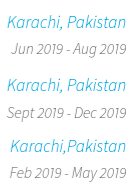 |
| My personal color preferences go against this choice. |
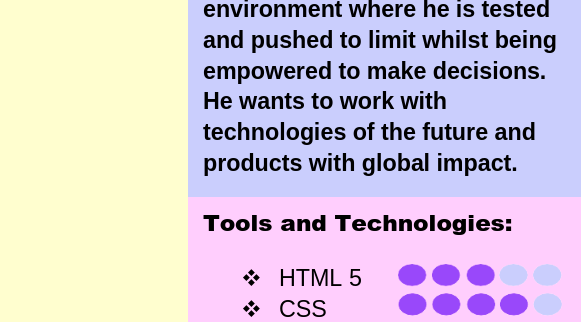 |
| The palette was noticed before the third person text. |
Breathing Space
Whitespace is just as important as text. Your text needs room to breathe, or it will suffocate. In an attempt to cram all your information on a single page, you will hurt your résumé if you reduce the font size, line spacing, margins or kerning. There is nothing more visually displeasing than a résumé with hundreds of technical abbreviations and no whitespace between them.
Let your résumé breathe and it will grow and thrive.
 |
| Too much information compressed in a tiny space. |
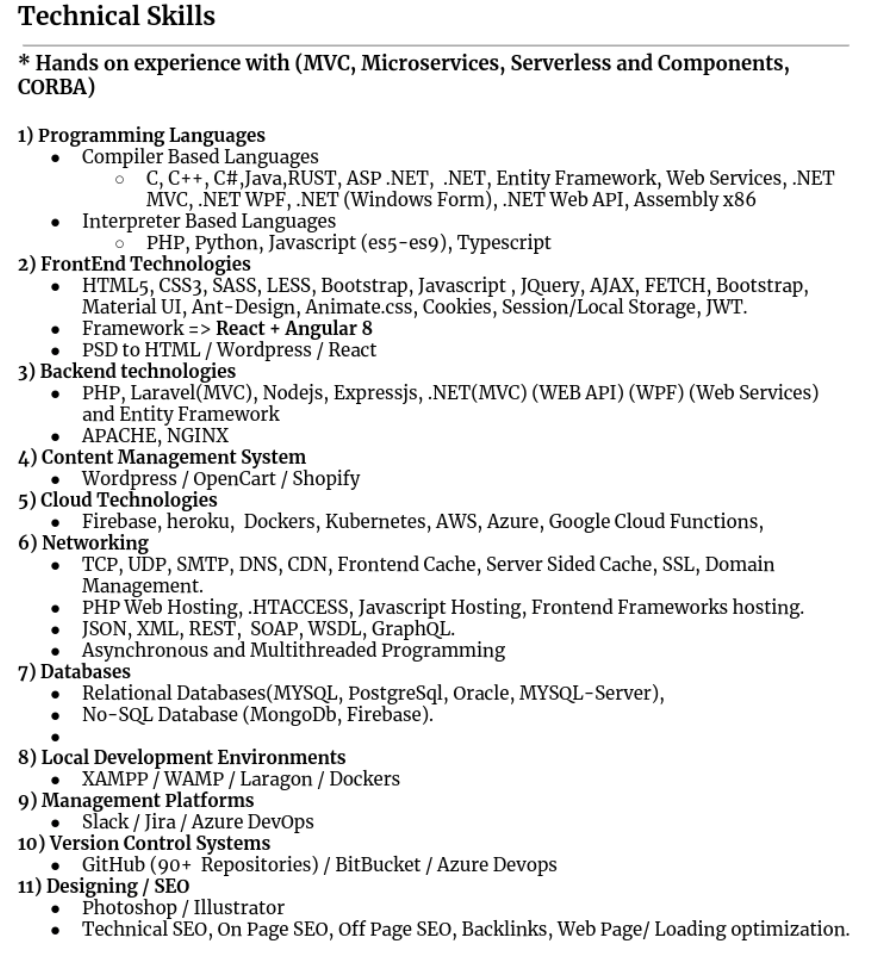 |
| Another glossary attempting to save trees. |
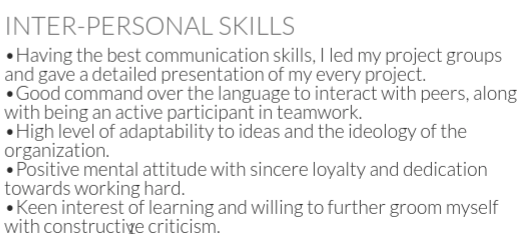 |
| The words fighting for whitespace. |
Fonts
Each font has its own personality, and ‘fun’, ‘exotic’ and ‘quirky’ fonts do not belong in a résumé. Choosing the wrong font is an indicator of your weak comparison and selection skills, and that is why the hiring manager has the authority and the motivation to reject your résumé early if he doesn’t like the font(s) that you have chosen.
Stick to professional, sleek and matter-of-fact fonts and avoid complicated, hard-to-read and embellished ones that want the reader to stare at their beauty instead of the résumé content. The corollaries around font sizes and emphasis are obvious, so you can figure them out yourself. If your template does not come with its own fonts, find a pair of fonts that work well together, so you can use one for headings and another one for content. Get critique on your font choices from other people, and make adjustments as necessary.
Spend more time on your résumé content than your font selection. Great content in a common font like Arial is much better than one with poor grammar and spelling mistakes in a beautiful font.
  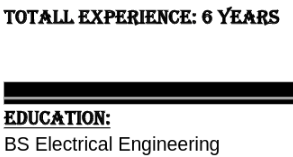  |
| Bad font selection at work. |
 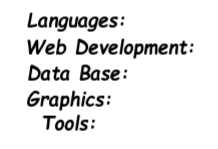  |
| Fun fonts give a childish personality to your résumé. |
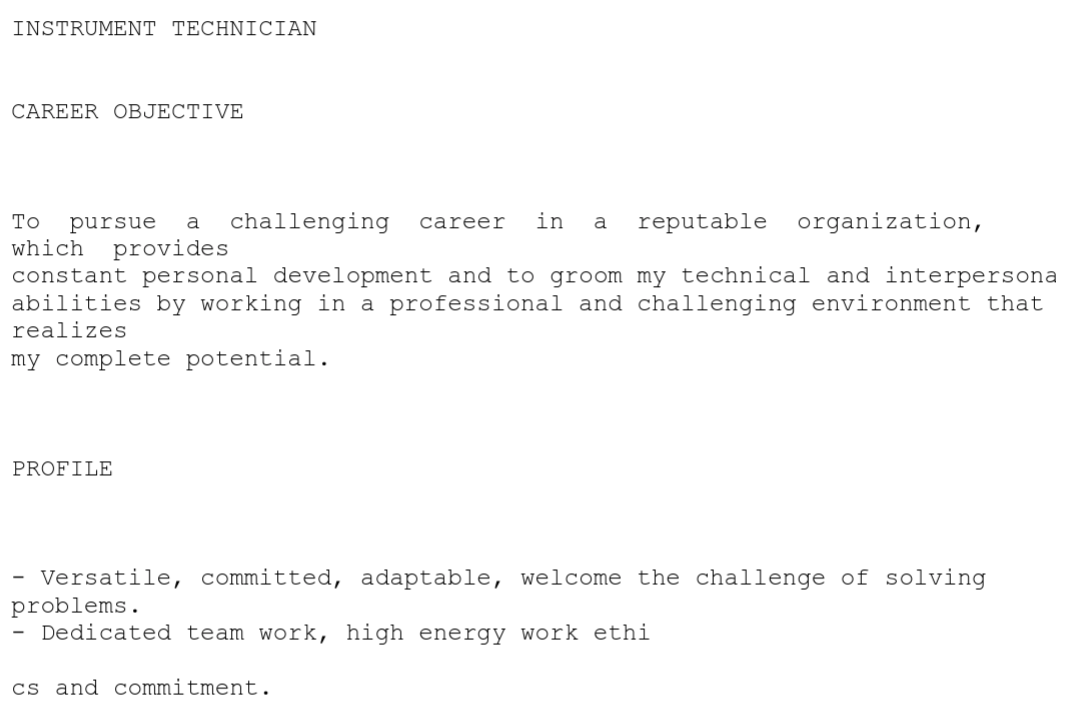 |
| Monospace fonts can work well when used correctly, but that is not the case here. |
 |
| This practical font pair is a sight for sore eyes after looking at the fonts above. |
Underlining
Underlining is a vestigial tool from the days of typewriters, when underlining was the only option when you wanted to emphasize important text. In present times, you have italics and bold, along with subtle font changes, to make parts of text more prominent, so use these modern devices and avoid underlining any text on your résumé.
Hyperlinks are an exception in certain scenarios, as they are expected to be underlined.
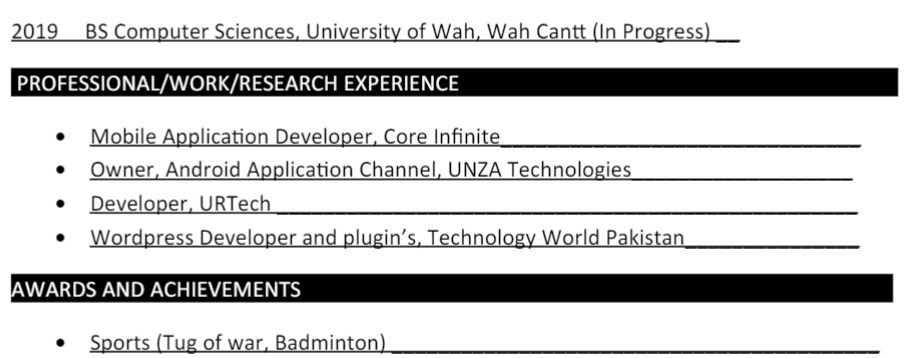  |
| Underlined text offers nothing that bold text does not. |
Logos
Even if you are an expert in twenty technologies, do not dump their logos on your résumé. The hiring manager knows what the HTML5 logo looks like, and the candidates who wrote ‘HTML5’ instead of pasting the logo probably know HTML5 well too. The ATS, on the other hand, does not parse images (yet), and that poses a serious disadvantage for your résumé. The twenty logos also need many times as much space as their text counterparts, and space is at a premium on your résumé, so use it wisely.
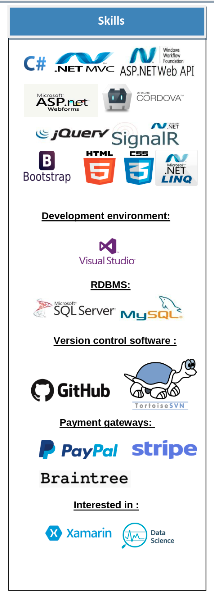 |
| Table |
Watermarks
I see absolutely no reason why a résumé should have a watermark, but I’ve seen a few ‘BS’ résumés. Maybe it is a template that people keep reusing, just don’t use watermarks. Please.
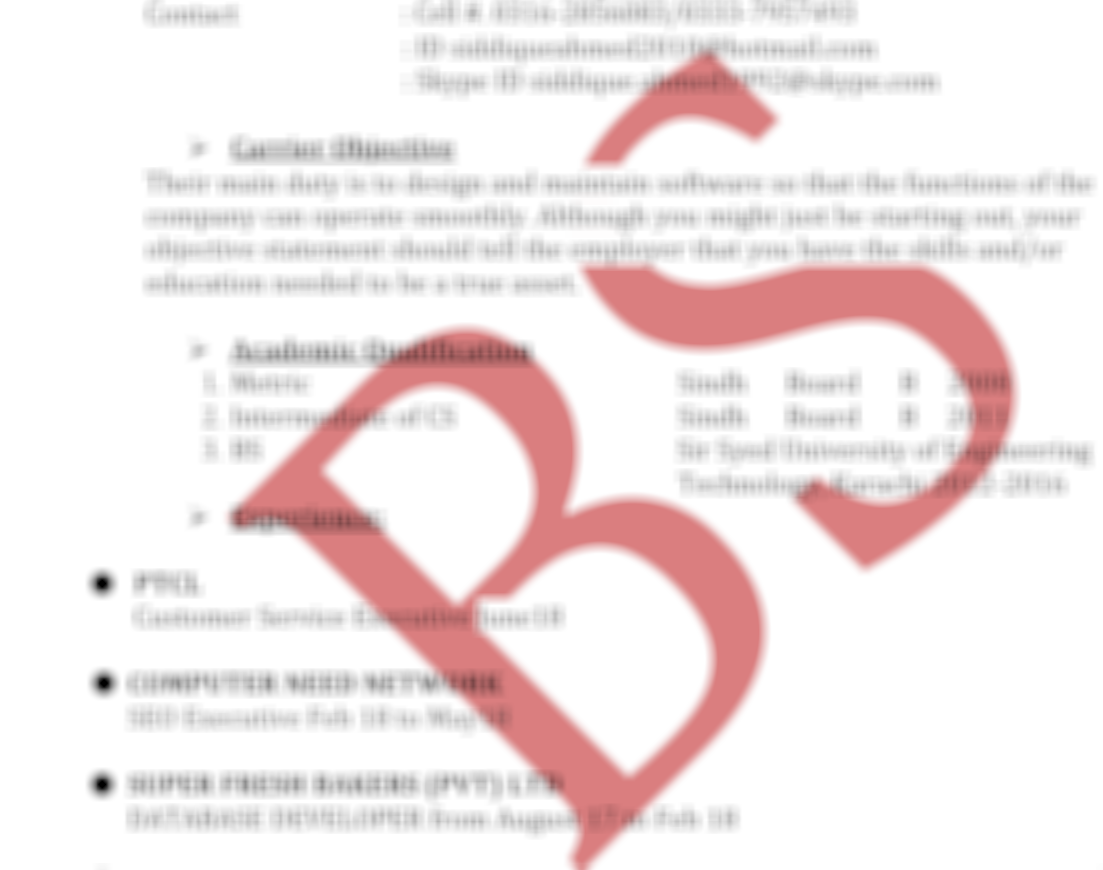 |
| An actual watermarked résumé. |
Number of Pages
The number of pages is probably the most debated topic when it comes to résumés. My take on this is simple, if you have an engaging three page résumé, hiring managers will invest the time in reading all details. If you have a single page messed-up résumé, it would be immediately discarded. The expected number of pages is usually directly proportional to the length of your experience, but there’s no upper limit for a zero experience candidate as such.
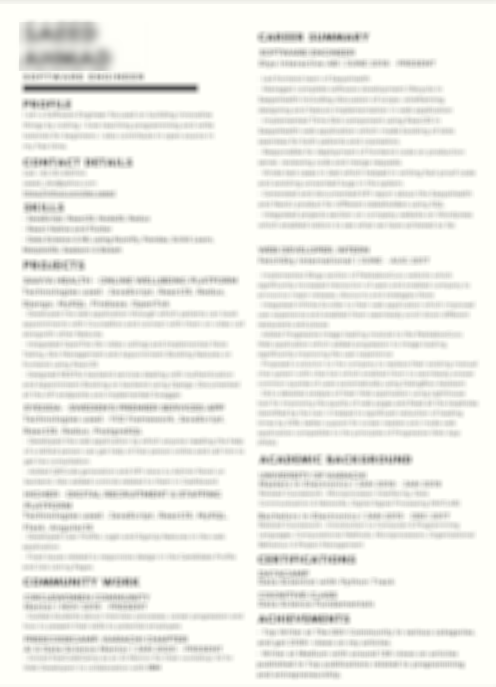 |
| This résumé managed to fit a lot of text into a single page, at the expense of scannability. |
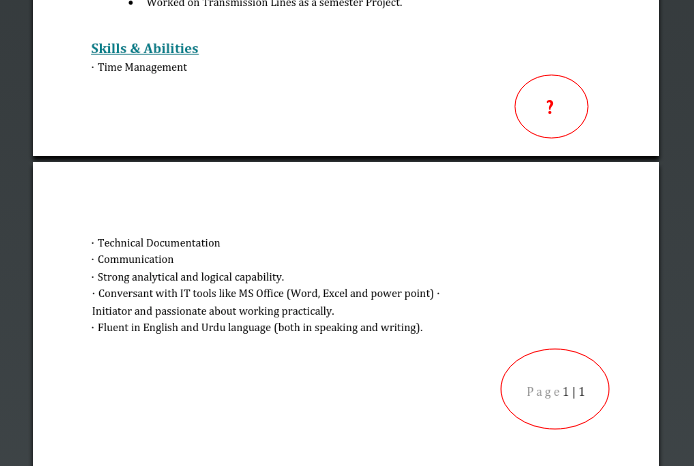 |
| Starting with Page 0 is one way of staying within a single page ‘limit’ |
Charts and Infographics
A picture may be worth a thousand words, and a neat data visualization in Tableau might look cool to you, but a skill chart just tells the recruiter about your charting skills. Self-ranking on arbitrary graphical scales beg for criticism, and in my opinion, should be avoided. Do us all a favor and just use words.
‘A thorough grasp of SQL, ‘Familiar with Java’, ‘Dabbled in PHP’ work better for people like me, and saves a lot of precious résumé real estate as a bonus. Your idea of a 70% C# knowledge is definitely different from mine, let the interviewer assess that during the interview. Read some Tufte to gain insights into information visualization.
 |
| Some of these skills ate power pallets, but a few bumped into ghosts. |
 |
| Does a 70% MySQL knowledge mean one knows SELECT, INSERT and UPDATE but not JOIN? |
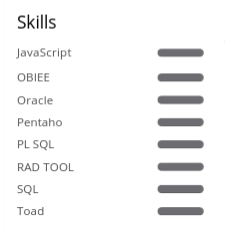 |
| Is that a 100% or 7%? |
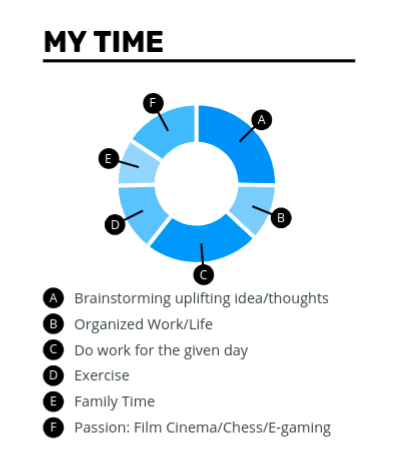 |
| G – Creating donut charts that don’t add any value to my résumé. |
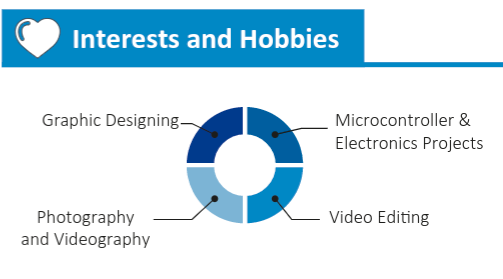 |
| If only everyone had the discipline to divide their time equally between tasks. |
 |
| I’m afraid 16/20 sticks in Javascript is a bit too low. |
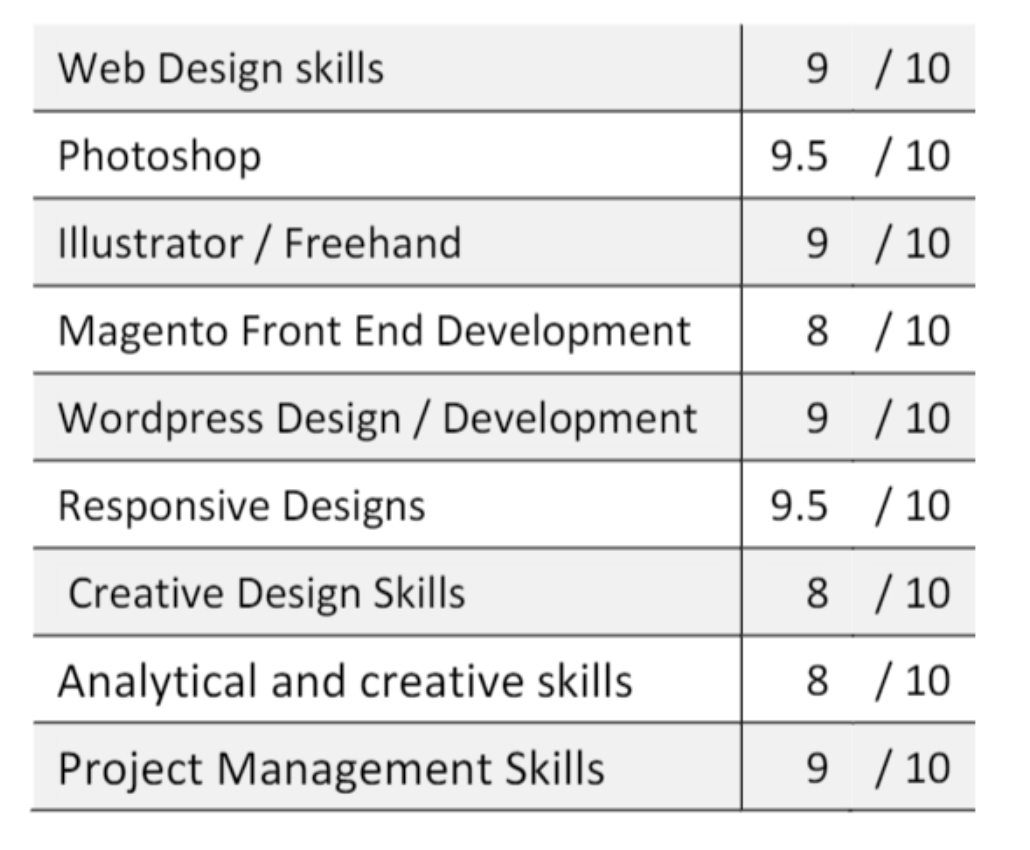 |
| A self-contradictory Design Skills table. |
 |
| Graphics for the sake of graphics again. |
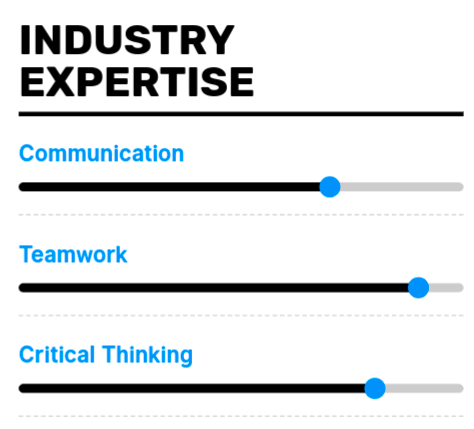 |
| Sliders are meant to be interacted with, not used as a graph, in my world. |
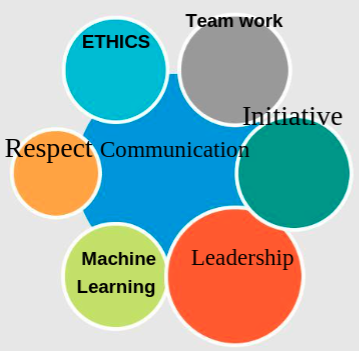 |
| Another example of pointless visualizations. |
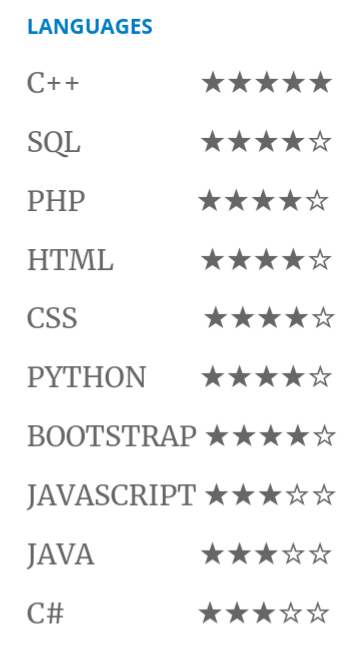 |
| ALIGNMENT SKILLS: ☆☆☆☆☆ |
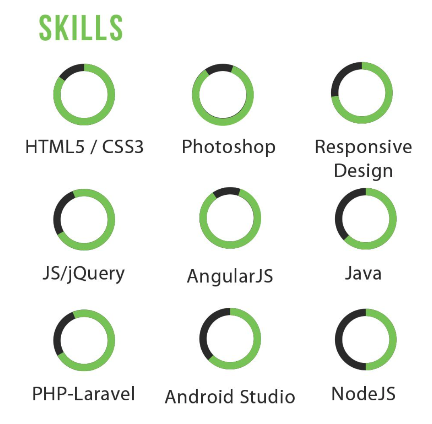 |
| Is that 12% HTML5 or 88%? |
  |
| These charts would have made a little more sense if the bars were sorted. |
Nested Grids
The information on your résumé should be organized under sections and headings with a semi-flat hierarchy. A nested grid just wastes precious space and is very confusing to the reader.
 |
| Nested Grids do not belong on a résumé. |
Blank Pages
Many résumés that I encounter have a final blank page, which used to make no sense to me, until I saw a résumé saying ‘Page left blank for comments’. Thank you, dear candidate, for showing me the light. The résumé was in pdf format, though, and I had no intentions of editing the pdf to leave comments, so I didn’t.
Even worse are résumés that have a dangling last line or two on the last page. If your résumé content gets you in that situation, either compress your text so that the line is moved to the previous page, or use the opportunity to add give your content more breathing room so the last line is not left alone.
 |
| This blank page was as useless as this image. |
 |
| The page that unraveled the mystery behind blank pages for me. |
Common Templates
Some universities have a résumé template or a résumé creator system that they share with each batch of students that is about to graduate. Most of the students use that template without second thought. After all, it looks nice, has their university’s name and logo in the header or footer, and they don’t need to go through the trouble of finding a template for their résumé. If that works for you, then use it.
Do realize, however, that the hiring manager in a well-known firm ends up receiving résumés from most of the students in your local universities’ recently graduated batch. Such templates accumulates their own personality and stereotype. As the recruiter receives more and more résumés based on a particular template, a mental model of a typical graduate of that university gradually builds up in the recruiter’s mind. If you are OK with being pigeon-holed due to using the university’s template, and with the fact that your résumé would be one among many similar résumés, that is your call. If you want your résumé to stand out, you should strive to make it stand out in every aspect, including the template, so instead of being part of the graduating herd of your classmates, you should consider using a unique design or template that is not shared by your classmates.
Similarly, the most popular job portals allow you to download a formatted version of your résumé when you upload your data on those websites. If you use a résumé that was created through this mechanism, at least make sure that it does not contain the website’s logo or URL, for obvious reasons.
This Bullet
 |
| One last thing – please don’t use this bullet. It is very irritating. |
Next: Part 5 – Parting Tips
Résumé Rejection Reasons – An Illustrated Guide – Part 3 – Résumé Content

Part 3 – Résumé Content
Let us take a magnifying glass and zoom in on the various faux pas in a résumé’s content that get it noticed, and not in a good way. If you can avoid these mistakes in your résumé, you make a huge leap up on the leader-board.
Capitalization
The rules of the English language are simpler than those of programming languages. You have studied both for years. If you still don’t know how to properly capitalize words, especially while applying for a software engineering position, your résumé would slide down many irrecoverable steps in the sorted priority list, probably because the hiring manager would imagine you trying to debug your code for hours to discover that the root cause was an incorrectly spelled variable in the end.
Learn the right case(s) to use for proper and common nouns, abbreviations and title case phrases, and use them consistently.
 |
| Respect your University name – use it as it is printed on your degree. |
 |
| CAPITALIZATION IS UTTERLY Unnecessary here. |
 |
| Perhaps the rule is to capitalize the first four months only. |
 |
| Two opposing perspectives on capitalization. |
Capitalization++
Proper capitalization is good, unnecessary capitalization is bad. Title case is rarely required in sentences in a ‘normal’ résumé.
 |
| This candidate would have improved his chances by not adding the above sentence. |
 |
| The capitalized A does create a certain kind of balance in this sentence. |
CAPITALIZATION
There is Capitalization, and then there is CAPITALIZATION.
CAPITALIZING EVERYTHING IS ONE WAY TO GET OUT OF THE WHOLE CASE CORRECTNESS CONUNDRUM, BUT ALL-CAPS TEXT IS REALLY HARD TO READ, AND HAS BEEN CONSIDERED AS SHOUTING, EVER SINCE THE LAST CENTURY. AVOID USING ALL CAPS TEXT IF YOU WANT YOUR CV TO SURVIVE THE FIRST FEW SECONDS OF THE FILTERING PROCESS. IT IS YOUR CV, NOT YOUR BILLBOARD.
Did the paragraph above hurt your eyes? Imagine a bespectacled hiring manager going through hundreds of similar résumés, and the relief that a nicely capitalized résumé would bring him. Save a hiring manager’s eyes. Don’t capitalize unnecessarily.
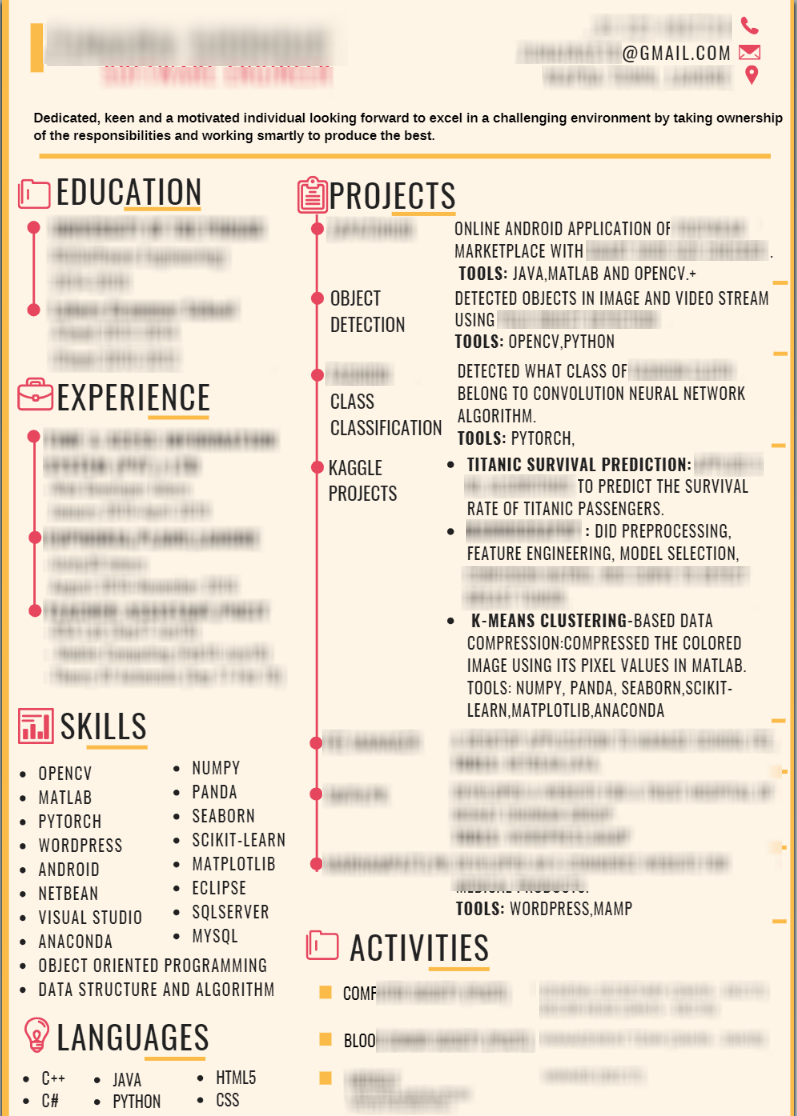 |
| My eyes! |
Spelchecking
Any spelling mistakes in your résumés are immediately noticed by the hiring manager (and your spell-checker), so there’s no room for error here. A résumé with typos is a résumé at the bottom of the rejection pile. Along with writing code, developers are also required to contribute to technical documentation, and nobody wants a teammate who can’t spell, and badly written documentation is an embarrassment for the whole team.
Use a spellchecker (or is that spell-checker?), and a grammar checker while you are at it. Its It’s free. Your future self would thank you for it.
 |
| I would not let this candidate come close to any production code, or documentation. |
  |
| Irony, illustrated. |
    |
| Watch your vowels. Remember: Extra Es elicit extreme expletives from the employer. |
 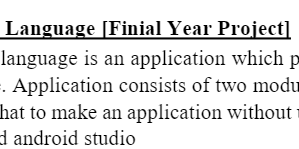 |
| One character could make or break your CV. Especially if your FYP revolved around language and patterns. |
Don’t Just Spell Cheque
Sometimes, relying on a spellchecker does not quite work out. Proofread your resume yourself, then get it proofread by others. Spellcheckers fail when it comes to technical terms and technologies, so it is up to you to be meticulous in ensuring the accuracy of any proper nouns that you use on your résumé.
| On the bright side, no spelling mistakes. |
 |
| My spellchecker doesn’t recognize ‘Steganography’ too. |
| Male chauvinism at work. |
 |
| Smiting is a dangerous activity, especially when paired with knives. |
 |
| The classic mistake. |
 |
| You keep using that word… |
 |
| Spellchecker approved. |
| We all know the universe is already a simulation, so just succeed. |
| This candidate was rejected because he couldn’t stand straight. |
| Stop, you’ll get tired. One positive reply coming up. |
| The candidate was probably codding! |
| Freudian slip? |
 |
| But of course! |
Proper Nouns
If the most important word to any person is their own name, then the name of the organization that they work for is at least somewhat important to them. Do not expect an interview call any time soon if you have misspelled the name of the company that you are applying to, either in your cover letter or your email. It is a big red flag and shows carelessness, while they are looking for meticulous candidates.
Any time that you mention the organization’s name, make sure that you use the official version of their name, as used by them on their official documentation or website, and not one from an alternate reality. If you are reusing an old cover letter, at least update the previous company’s name in your cover letter before mailing it to the next company – this is a faux pas that is hard to recover from.
All of the above also hold for your previous employers, educational institutes, and your own name.
While we are on the topic, please don’t address me as Zohaib, Shoaib, Sohail or anything else besides Sohaib in your emails.
 |
| This candidate sent an old cover letter without changing the firm’s name, for a job that was not a UI/UX Designer. |
Punctuation and Whitespace
If you can not grasp the simple concept of how and when to use a comma , an apostrophe or aspace,a hiring manager ,consciously or subconsciously,would notice the error, and you know what that means. The same goes for dashes-and periods and ellipses..
  |
| Space before comma, space after comma, comma after comma, anything goes. |
 |
| When in doubt, add an apostrophe. |
| ‘Hands-on’ is a common mistake that I keep coming across. |
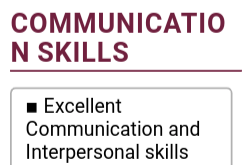 |
| Watch how your words wrap, especially if the word is COMMUNICATION. |
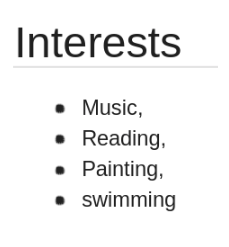 |
| Bullets are not sentences. |
 |
| At least the dates are consistently wrongly formatted. |
 |
| Extra spaces in technology names are twice as important as spaces in other words. |
 |
| Words are not sentences. |
 |
| Is it a list? Is it a sentence? |
 |
| If, like me, you are in the habit of using nested braces, open and close them properly before applying for that C++ job involving compiler construction. |
Writing in the Third Person
Sohaib thinks that anyone writing a personal statement or a cover letter in the third person is asking for the résumé to be thrown on the rejection pile. Sohaib believes that you can do better, and urges you to not make this mistake on your résumé. Heed Sohaib’s advice and use the first person throughout on your résumé.
 |
| Sohaib was amused when he read this personal statement. No interview though. |
Dates
Your résumé is a chronological record of your academic and professional life, and hence, it contains a bunch of dates. The Goldilocks Zone of date precision changes from case to case. You would want to mention the year alone for certain older events, while more recent events may require the month as well. Use your common sense while mentioning dates.
August 2020 is easier on the eyes than 2020-08 IMO, but feel free to disagree. Whatever format you pick, aim to be consistent in date formatting throughout your résumé.
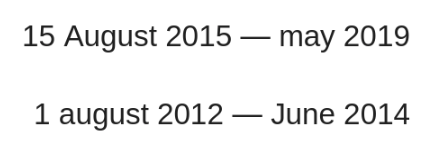 |
| Capital A hath August, except when followed by 2012. |
Technical Terminology
Developers’ résumés need to be heavy on long lists of languages and technologies. Any time you mention an abbreviation or a brand name, ensure that it is capitalized and spelled properly.
If Microsoft uses ASP.NET everywhere, then Asp.Net or asp.net is wrong. If you are unsure about whether to use Nodejs, Node.js or NODEJS, look it up on the official website.
Hiring Managers for development positions, like C++, are also case-sensitive, and expect the candidates to be case-aware.
If you haven’t been in heated arguments around the pronunciation of Linux, the softness or hardness of the g in gif or the correctness or incorrectness of ‘Star Trek’, you may need to get into that mindset before you join a seriously technical workplace.
Seriously though, if you can’t spell a technology name correctly, why would a hiring manager believe that you’ll be able to follow the coding conventions used by his team, much less to be great at programming in that technology?
| If this were an exam, the candidate would have recieved 5/13 marks. |
 |
| Sorry, we were looking for Prolog experience. |
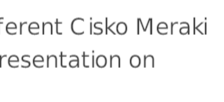 |
| A bad speller, or a DS9 fan? We will never know. |
| Pressing the shift key shouldn’t be that tiring. |
   |
| Another assortment of typical careless errors. |
 |
| Pi. Pie. π. Whatever. |
 |
| Too lazy to use the shift key? |
URLs
The one good thing about electronic résumés (as opposed to their paper-based ancestors) is that they can contain hyperlinks. It is up to you – you can take advantage of the hyperlinking and hope that the hiring manager is curious enough about you to click and visit your Github or blog, or you can avoid creating links and hope that they will put in the effort to type your LinkedIn profile URL, which still has the default random strings in it because you did not customize it. (Spoiler alert: He won’t).
Each time the recruiter finds a hyperlink for a long URL in a pdf file, they silently thank you for caring for them.
Also understand that underlining your URLs does not automatically make them hyperlinks.
If you are using a résumé template, make sure that you change ALL links in the template to your own, and not just the text for the URL.
   |
| Don’t make the recruiter work even before they’ve hired you. Link. |
| Your LinkedIn URL is not whatever is in your browser address bar. |
| A rare example of how to create and signify your outgoing links without clutter, though not recommended for LinkedIn profile. |
Fill the Template
Résumé templates are amazing. They save you from the effort of creating a visually pleasing layout, choosing fonts, and the rest of the work that you’d rather avoid. With all that work cut out for you, you have one job – to fill the template accurately. You need to do it well.
If you forget to fill in the sections that should either contain your contact information or be taken out altogether, then forget about getting an interview call.
 |
| I couldn’t call this candidate for an interview, because, no email! |
 |
| Please, when it says ‘Type your e-mail address’, type it! |
 |
| My sneaky pdf reader displays the pdf metadata for the original author of the résumé template. |
Don’t Copy the Copy
If most of your résumé uses broken and incorrect language, the reader would immediately detect an anomaly when he encounters a perfectly polished paragraph or sentence. If a simple Google search on that sentence, in quotes, leads him to a résumé template or someone else’s résumé that is the actual source of that paragraph, that is enough reason to reject the résumé, for me at least.
Do yourself a favor and ensure that your resume is actually entirely yours.
Exaggeration
When you make a claim, whether it is about being an expert in a certain technology, your duties in a past job or the years of experience that you have in a language, the hiring manager has to take your word it, until they assess you during the technical interview. If you exaggerate certain aspects of your skills or experience, the truth will eventually come out during the interview, but if your exaggeration is not technically possible, it can happen much sooner.
Be truthful in stating all facts on your résumé, so that the interviewer’s expectations are proactively managed.
 |
| 20 years of experience in a 10 year old technology – I want to borrow this candidate’s time machine. |
Lies
A little amount of exaggeration is acceptable and even expected in résumés, as the candidate’s perspective and measurement scales are never fully aligned with the hiring manager’s, and many things included in the résumé are purely subjective. Lies, on the other hand, are a deliberate manipulation of facts, and if exposed, the candidate is usually blacklisted in that firm for future applications. Lies can be as small as inflating your GPA, or as serious as adding fake past experiences or job titles to your résumé. Most firms employ third party candidate validation services, so the best policy, as always, is honesty.
I recently received a candidate’s résumé who had worked for me a few years ago. His past experience from that period in my team included projects that he never worked on, in technologies that were never used and with accomplishments that were not possible. Needless to say, he was immediately rejected.
Please don’t lie on your résumé and present the facts as they exist. You’ll sleep better at night.
Ambition
We all want to hire ambitious employees with passion and drive, but if you just graduates and have nothing exceptional to show on your résumé, do not apply for leadership or managerial positions such as Architect or Team Lead – positions that demand multiple years of experience. If someone gave you the advice to ‘Apply everywhere, you’ll never know when someone might give you a call.’, forget that advice and be very selective about your applications. If you apply for a job that you are unsuitable for, your application for a job that you are a perfect fit for might get rejected.
Weak Words
Words are powerful, and they are the only tools you have when creating your résumé. Choose them carefully, and consider the nuances in their meaning as if your life depended on it (it does). Realize the difference between ‘I was a team leader for five projects’ and ‘Led a team of six and delivered five web application products successfully’. A lot has already been said on the use of adjectives and verbs on your résumé, so I will expand upon this topic later.
 |
| OK… |
Know Thy Audience
Create your résumé as if the hiring manager is sitting in front of you, watching your every move and scrutinizing every word. Does it look like he knows Chinese? If not, then write your résumé in English. Is he a C-level executive? Highlight the value and profit that your work brought in your past jobs. Is he a hard-core software developer? Explain the elegant architecture that you implemented for your last project.
If the imaginary hiring manager sitting in front of you is not satisfied with the final product, keep working on it until he is.
 |
| An actual résumé that I received for a job application that had nothing to do with China or the Chinese language. |
Next: Part 4 – Résumé Design
Résumé Rejection Reasons – An Illustrated Guide – Part 2 – Résumé Sections

Part 2 – Résumé Sections
Let us take a quick and critical look at some of the common sections that a résumé is supposed to contain, in roughly the same order in which they are expected, starting with…
Name
Please use your complete name in your résumé header, properly capitalized and spelled the same way as your degrees and documents. I am sorry to have to even mention this, but I occasionally see candidates who misspell their own names.
Résumés with misspelled and incomplete names on a résumé do save the hiring managers some time by allowing them to make an early rejection decision, but we’d rather receive résumés that are good enough to spend some time on.
Some candidate pigeon-hole themselves by adding a byline with their names, mentioning the professional role that they identify with. If you are a recent graduate, realize that calling yourself a ‘Data Scientist’ might look attractive in 2021, but you might lock yourself out of other opportunities if the recruiter does not redirect your résumé for another relevant role, like ‘Software Engineer’, because other roles because you tagged yourself differently.
 |
| If you are really mononymous, there is no need for a comma. |
Contact Information
There was a time where there was no email. it was a dark time, when one had to submit a printed résumé for each job application, and the prospective employer had to respond by snail mail, or by calling a landline phone. Your complete street address was required in those days. You were probably not born then.
Times have changed, and the world is a better place. The only contact information you need to include in your résumé is your email, your cellphone number, and perhaps your city and country, but only if the situation calls for it.
Landlines are not really necessary unless you live in an area where cellphones don’t work, and adding multiple phone numbers or emails to your résumé could cause confusion. Your complete street address eats up precious pixels, not to mention the recruiter’s time, so put those pixels to a better use.
Give your LinkedIn profile a prominent place in your contact information. It probably has the same information as your résumé, but it may be updated after the résumé is submitted. It also lets the recruiters view your recommendations and mutual contacts, and all of that increases the probability of your application’s passage to the next stage.
| Space saved by not adding your address pictured above. |
Picture
Depending on the country that you’re applying in, including your picture might work against you, so error on the side of caution and avoid adding your picture, especially if it is a full body shot, taken at a wedding that you attended last week, or a scan of your paper photograph.
Technology recruiters are interested in your experience and skills, so your photograph is really not going to help you land that database modeling position, although a picture might help if you are applying to be a fashion model. In some countries’ laws, photographs can trigger biases and discrimination, so hiring managers may actually stay away from résumés containing photographs.
Avoid embedding your picture in your résumé, but if you really want the recruiters to take a look at your beautiful face for whatever reason, a good compromise is to place your LinkedIn profile in a prominent position. The recruiter could click through and see your profile picture if they want.
If you still insist that adding your picture to the résumé is the right move, go ahead, I can’t stop you, but at least ensure that it retains its aspect ratio and that it is a digital image and not a scanned picture of a printout, the latter smells of carelessness.
 |
| Be like Lena Forsén. |
 |
| Not like a squished Lena Forsén. |
 |
| Preferably like a professional Lena Forsén. |
(Too Much) Personal Information
Similar to the pointless practice of pasting a picture on your CV, including too much personal info that is unrelated to the job application is a waste of space and potentially hurts your chances of getting a job, not because the recruiter does not like your zip code, but because it depicts that you can’t distinguish between what is necessary and what is useless information.
This is not your Tinder profile, so does a recruiter really need to know your age, height, weight, religious or political affiliations, marital status, sexual orientation or your pet dog’s name?
 |
| The qualification and the email are the only useful facts in the above list. |
Personal Attributes
This section goes by many names, ‘Personal Attributes’, ‘Strengths’ and ‘Soft Skills’ are a few, and it is usually presented as a bulleted list of subjective opinions around your self-image that may or may not be accurate. Hiring managers will take this list with a bucket of salt, after all it is your self image, and you wouldn’t admit to being a little bit tardy, or that you have average problem-solving skills, on your résumé.
You know how awesome you are, but instead of enumerating all your positive traits in a bulleted list, allow the hirer the pleasure of discovering your potential and personality for themselves, during the interview, or after they hire you. Do work these adjectives into other sections’ content, such as Experience or Achievements, with supporting evidence.
A ‘Received the punctuality prize at OfficeA thrice’ in the Achievements section is more believable than a ‘Punctual’ in this list.
   |
| If you claim to be “detail oriented”, walk the talk and demonstrate it through proper grammar, punctuation and spelling. |
  |
| These attributes spark joy in my heart. |
 |
| Soft(ware)? skills. Very ‘Creative’. I think. |
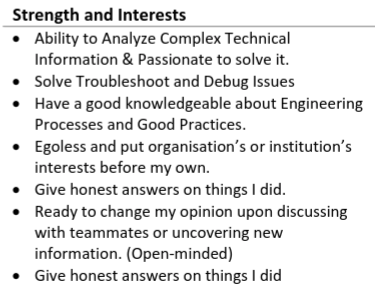 |
| Please tell us what did you do. Please tell us what did you do. |
Skills
Don’t SEO your CV by overloading it with all the skills that you possess, have read about, taken a Udemy tutorial on, or touched briefly as the name was displayed on your screen – unless you are a hundred years old and have lived on more than one planet.
Even though exceptional candidates do occasionally pop up, but if you are a regular freshly graduated candidate or one with an year or two of development experience, adding a long list of technologies that you [think you] are an expert in, could get you an interview, but the interview would not last long. The hiring manager would do some mental calculations and arrive at the conclusion that the probability of you having lived long enough to invest the time needed to develop an expertise in these fifty technologies, and that too while completing your four year degree and juggling five balls five hours per day, is extremely low.
Relax, and mention the top five or so technologies that you are really really good at, after making sure that those skills overlap the job description. You will ultimately be assessed on how well you know your languages, not how many languages you know.
 |
| This résumé came with a glossary, but it wasn’t alphabetized. |
 |
| This CV had PRESENTATION SKILL, and was partially alphabetized. |
Tools
Some candidates add a ‘Tools’ section to their résumé, where they list all the IDEs and other software that they have used, however briefly. The rule, or suggestion, of thumb is – if it takes a day or less to learn, don’t mention it.
Notepad++ used to be an excellent editor, but is it really worth a mention on your CV? If you list Microsoft Office as a tool, you may as well add Chrome, Internet Explorer, Firefox and a dozen other browsers while you’re at it (and some candidates do indeed do that).
Imagine yourself telling ‘I know how to use [Tool Name]!’ to an interviewer – your résumé would benefit from having that tool listed only if your imaginary interviewer responds with a ‘Nice!’ or ‘Awesome, that’s what we use here as well!’ instead of an ‘OK…’.
Typing Speed
This warrants just quick mention for completeness’ sake. I have noticed a recent increase in résumés that mention typing speed. Maybe it is a Millennial thing – typing speed could be an exotic metric for the texting generation, but for a software development position, variables per minute, functions per hour, classes per day, bugs per feature or story-points per week would make slightly better metrics.
Don’t mention your typing speed, unless it is 200+ wpm, in DVORAK.
 |
 |
| It’s a good thing we have a typing speed limit at work here. |
Education
The Education section is expected to be near the top in case of fresh graduates’ résumés, as they have no professional experience yet, but it is normally placed after the Experience section for candidates with a job history, so unless your education is more noteworthy than your experience, follow this convention.
Use Reverse Chronological Order
Recruiters are much more interested in the university that you graduated from than the kindergarten you attended, so listing your education in the latest first order should be a no-brainer, and yet many résumé authors still make this mistake. Use chronological order when you publish your autobiography, use reverse chronological order when you write your résumé.
If you have started applying for a job while still studying, mention the expected date of degree completion, so if you write ‘2016 – December 2020 (Expected Graduation)’ instead of ‘2016 – Current’ in your Education section, it enables the recruiter to decide if they want to wait till you graduate and keep a position open for you. A ‘Current’ does not tell them whether you are in a two year or a three year program, and when will you be available to start working.
Avoid Course Dumps
Most computer science degrees offer similar courses, but if you majored in a unique topic, or one relevant to the position you are applying for, feel free to briefly mention it in the appropriate section. In all other cases, please do not dump all the courses from your syllabus on your CV. It makes your CV boring. If you are a fresh graduate with a spark of brilliance and the potential to learn, it will show, and you’ll be hired even if you didn’t take the course that is the most relevant to the job.
An alternative is to mention each course along with the academic project that you are adding to your résumé, so ‘Online Applicant Tracking System using Node.js and Angular 3 (Web Programming Course)’ is a superior organization that links your projects to your courses.
If you mention the top three or five subjects from the twenty that you studied – ones that are actually relevant to the job that you are applying for, it shows that you paid attention to the job description and made the effort to tweak your résumé for the position, which earns you some more brownie points, as fresh candidates rarely do that.
 |
| Five more seconds wasted here. |
Your GPA Doesn’t Matter Much
Your GPA does not matter as much as you think it does. Some companies do have a lower limit on the GPA, but most seasoned recruiters realize that our education system is flawed and there is only a weak correlation between your capabilities and your GPA. If you have a good CGPA, do mention it on your CV, but don’t fret if it is low, and skip it altogether if your grades were below average. If you can demonstrate what you are made of, during the interview, your GPA will be disregarded, at least by me.
 |
| This candidate was rejected due to an 88.825% minimum limit. |
| Skipping the grades would have landed this candidate an interview. |
For every degree, certificate and qualification, mention the full name of the institution and its location and not merely its abbreviation, to avoid confusion. For instance, there are dozens of BUs in the world, which one did you attend? Dates matter more for an entry-level position than one requiring a decade or two of experience. When appropriate, eliminate a few characters and keep your résumé clean by limiting the dates to the year only. Recruiters don’t care about whether your graduated in March or September, unless you are still studying, in which case, the hiring manager would be interested in when you’d be able to join.
Final Year Project
Fresh candidates usually mention their FYP in the education section, so if you do, make sure that you have an in-depth knowledge of the topics that your FYP focused on. A significant part of a fresh graduate’s interview is normally spent around their FYP as it is their most complex work to-date.
If your FYP was a group project, you can delight the hiring manager by explicitly mentioning your exact role in the group, as that will save them some time when they don’t have to ask the question during the interview.
  |
| Don’t call your ‘Final Year Project’ a ‘Final Year Project Project’. |
MOOC Addiction
MOOCs are the MORPGs of the cerebrally inclined. If you have completed more than a dozen MOOCs and intend to dazzle the CV reviewer with that list, try to make sure that you can complement the MOOC list with a project or three that demonstrate that you put your learning to actual use.
These days, those who can, do; those who can’t, do MOOCs. Recruiters are really not looking for people who can create a To-do list in fifteen languages and frameworks. A couple of interesting projects that you created from scratch without following a tutorial make your résumé shine more brightly than twenty introductory MOOCs.
 |
| This candidate had breadth but no depth. |
Experience
Experience is perhaps the most important section on your résumé, and like your education, should be listed in reverse chronological order. You may be tempted to name it ‘Employment History’ or something else, but you are creating a résumé, not a crossword puzzle, and the ATS may not like your interpretation of ‘Experience’, so avoid such creativity. Less is better.
For fresh graduates, ‘Internships‘ replace ‘Experience’, but the principle is the same. Each experience item should not merely contain the job title description that you were hired for, but also a brief description of what you were tasked with and what you accomplished in that position. If you made an impact on the profitability and the bottom-line of your employer, the hiring manager would like to hear that. If you worked at a small, relatively unknown company, a sentence or two about the nature of their business and a link to their website helps the recruiter as well, and anything that helps the recruiter make sense of your résumé helps you.
A résumé with an experience item that begins with ‘Successfully developed and deployed…’ wins against one that starts with ‘Worked on…’, or worse, ‘Had to work on developing…’. Action words and numbers that quantify your accomplishments are the way to go when writing your job experience. There are long lists of action words usable in résumés available online, so find one and use it.
If you ‘Improved IntSys for SomeDep by implementing the NOC-LUA-8L protocol’ at a past workplace, realize that the internal system for some department is something the recruiter will have absolutely no clue about. You should either simplify what you accomplished into something that a clueless recruiter, your grandma or your eight year old brother would understand, or not mention the technical details at all.
On the flip side, do use the names of the most important tools and technologies that you had to got to use during each employment period.
Versatile engineers get to fight on multiple fronts, so you may have designed databases, written back-end APIs and designed front-ends all by yourself in your present role. If that is the case, highlight the skills that are relevant to the job that you are applying for but mention the secondary roles that you filled, to customize your résumé for the position.
| I find your lack of enthusiasm disturbing. |
Language Skills
Candidates normally mention English, and their mother tongue (Urdu in Pakistan) on their résumé as their language skills, but I personally think that it is a bad idea. Even if English is a secondary language for you, your education was most likely in English, so proficiency in English communication in all forms is an implicit requirement for most jobs.
Being a rock-star developer is sadly not good enough these days. If you aim to work for an international organization, the hiring manager needs to know that, once hired, you would be able to confidently represent his/her team in internal and external meetings where English is the official language.
If your English writing skills are lacking, get your résumé reviewed and edited by someone who knows English well, while you take up an English conversation course to improve your chances for the interview. If your résumé itself demonstrates your English skills through short, concise and clear sentences, you don’t need this section at all.
If you are a polyglot and can speak four international languages along with a couple of dead ones, definitely mention the fact in your résumé. Please do not add C++ or Java – that joke got old in the last century.
 |
| The words speak for themselves. |
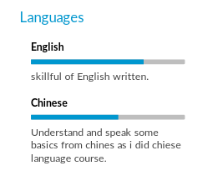  |
| Say no more… |
Personal Statement
Hiring managers expect an engaging, creative, relevant, coherent and unique personal statement, objective, or whatever they are calling it these days, if you can’t write one, don’t copy someone else’s life-goals as your own, or fill it up with clichés.
Even if ‘Working at a challenging position in a dynamic organization that allows personal growth’ is all you’ve ever dreamed of, please don’t be another brick in the wall by adding similar sentences to your résumé. Consider replacing the ‘Personal Statement’ with a ‘Career Summary’ – the former is more about what you want, while the latter is about what you have to offer.
Either way, definitely do not copy/paste a personal statement from some Google search results. We will know.
Avoid using ‘I’ – so instead of using ‘I am a front-end developer for the last two years. I have expertise in Angular.js and Node.js’, use bullet-point style text along the lines of ‘Front-end Developer with two years of experience. Expert in Angular.js and Node.js’.
Cheesy quotes in your personal statement are better avoided, but if you do quote Nietzsche, be prepared to discuss his books during the interview. Your personal statement would also be used to grade your English skills, so ensure that it as well-crafted as an international brand’s slogan.
Here’s an assortment of real-résumé snippets that demonstrate how not to write your personal statement. See if you can spot the problems in the personal statements below, and ensure that yours is clean of similar mistakes.
 |
 |
 |
 |
 |
| Exhibit A. |
 |
 |
 |
 |
 |
 |
| Exhibit B. |
 |
 |
 |
 |
 |
 |
 |
| Exhibit C. |
Social Media Profiles
Opinion varies on whether including your social media profiles in your CV is the right thing to do or not, and is usually based upon the opiner’s generation. Gen Xers may think that social media profile links in a CV are unprofessional, Xennials like me may tolerate them, and Millennials and Gen Zers may welcome or even expect social media profile links. There’s no one-size-fits-all, so use your common sense (the one you used to buy that magic juice) to decide whether or not your social media links belong on your CV.
I personally like to see Facebook and Twitter profile links in résumés, as they give me a valuable, uncensored and honest glimpse into the candidate’s personality (and their communication skills), and their social media accounts contain a lot more information than their carefully crafted single-page CV. As a general rule, do not include any URL for your social media presence if you think that your profile, if projected on a huge screen at your future workplace, might cause you embarrassment.
That being said, here is my recommended set of guidelines to help you decide.
Do include your Facebook profile link on your résumé if your posts highlight your academic or professional achievements, your interesting hobbies and your original opinion on life, the universe and everything. Do not link to your Facebook profile if all you do is share memes, or if your posts supporting your favorite sports team tend to bend towards expletives. Make sure that your Facebook profile is public if you do share your URL, the recruiter is certainly not going to send you a friend request.
Add a link to your Twitter profile if you have been retweeting industry-specific accounts and/or your tweets contain original thought, we like people with focus, direction and creativity. Do not link to your Twitter account if your tweets are retweets or political commentary only, or if your account is protected.
If your Instagram account has original pictures taken by you, it might help ascertain that you are an artistically gifted individual, so you can consider adding it to your résumé. If it is full of memes, it does not belong on your résumé.
YouTube
If you are an online content publisher and have a YouTube account to show for it, by all means, link to it, especially if your content is relevant to the job that you are applying for.
Quora
Definitely share your Quora account link if you regularly answer questions relevant to your industry, or even if you are an authority on a unique topic or hobby and your Quora account highlights this fact. Do not link to your Quora account if you have no activity there.
Github
While not a ‘social’ platform, your Github account is the first link that a hiring manager would click if you are applying for a development position. It would add value to your CV if you have contributed to open-source projects, have been a consistent pusher on your own projects or even if you report bugs in the open-source projects you use, as this means that you want to make the world a better place.
If you have written original, clean and useful code and not merely forked existing projects, mention the fact in your résumé when linking to your Github.
Do not link to your Github if it is empty (that does happen) or if you created your account last month and quickly uploaded your university assignments there. It is disappointing to visit such an account.
Behance and Dribbble
Include your design portfolio URLs if design skills are fully or semi-relevant for the job you are applying for. If you are applying for a hard-core engineering position and the technical experience on your résumé is small in comparison with your website design work, it might suggest that you are a designer at heart and are applying for an engineering job because you have a degree. You might still get an interview, but do reflect on what you want to do with your life – it is probably not software engineering. On the other hand, including your design portfolio could be a positive if you are applying for a front-end engineer or a ‘Full Stack’ opening.
Code Pen and friends
Codepen is intended to share and test quick code snippets, so you should use Github to showcase your code instead.
Stack Overflow
As with Github, share your StackOverflow account if you have a good reputation there through answering questions, or even if you ask for solutions to complicated problems that you were stuck with in the past.
The questions you ask say a lot about you. Do not share your StackOverflow account if you were running out of time on an assignment and asked about how to balance a red-black tree during your studies – or such basic questions for which a Google search would have sufficed.
Upwork and Fiverr
Freelancing can be a double-edged sword when applying for a job. On one hand, if you have an impressive set of client referrals, it shows that you are an achiever. On the other hand, if you are too deeply involved in freelance projects, there is a high probability that you will continue to do so after you get a ‘regular’ job, and hiring managers have to consider the possibility that they won’t be receiving 100% of your focus.
In the past two decades of my career, there have been a couple of times when the person I hired was more interested in his freelance projects than his day-job duties, and his performance suffered due to this attention deficit.
In the end, the choice of whether to mention your freelance work and portfolio URL or not is yours, and there is no one-size-fits-all recommendation.
Medium
Definitely mention your Medium account if you have written more than one article there. Do not mention it if you go there to read and clap only.
Blog
Whether your blog contains your personal musings or your commentary on technology, if the content is not offensive, showcases your communication skills or highlights your creativity and connection with your profession, sharing a link on your résumé would obviously be the right move.
Reddit, Gist, Goodreads and Niche Platforms
The gist of the pattern is, any social network that is an evidence of you being a creative, intelligent, talented and interesting human being (that’s the type of a person that most hirers are searching for) should be included on your résumé. The person reviewing your résumé may not have the time to scan all your social media presence, but if they do, it will help increase your chances of at least landing an interview.
Achievements (and the Prime Minister Laptop)
Some context for the non-Pakistanis – once upon a time, in Old Pakistan, an Oprah-inspired Minister thought it would be a good idea to ‘promote’ the IT industry by distributing hundreds of thousands of free laptops to his future potential voters, because he could – so everybody got a free laptop. The eligibility criteria was to score marks above 60%-70% in school, which is an ‘achievement’ that would probably be tagged as ‘disappointment’ in our Asian tiger moms’ rule books.
If you are one of those students, please realize that a Prime Minister Laptop was not exactly an ‘accomplishment’ per se, it was just an event that you happened to be a part of, along with hundreds of thousands of others. Don’t mention that laptop on your CV, unless you created something worth mentioning using that laptop. Even then, share that worth-mentioning creation of yours, and not the fact that it was created on the Prime Minister Laptop.
I realize that the Millennials grew up around participation certificates where everyone is a winner, but the real world is still ruled by the Gen Xers, so anything that can elicit a ‘So what?’ from your brutally honest friends or your friendly recruiter should be excluded from your CV as a general rule, especially achievements that begin with ‘Participated in…’ if it isn’t followed by an ‘… and won…’.
 |
 |
 |
 |
 |
 |
 |
 |
 |
| I’d take a ‘Bought my first laptop from money I earned myself’ over these achievements anytime. |
Achievements (and the Tic Tac Toe Résumé)
Maybe Tic Tac Toe was the first game that you programmed, and experienced that Eureka moment. I totally get that, and yearn to relive the excitement of getting my first few programs to run correctly. Unfortunately, you’ve had four years of education since you wrote that Tic Tac Toe (you did write it in your first semester, right?), so your CV should reflect that. At best, a Tic Tac Toe program could be a kata when you are learning a new language, but all it does on a résumé is to eat up valuable space. If you have not created a moderately complex program to replace your Tic Tac Toe entry with, stop your job search immediately and spend a week to create a few.
Any simple project doable in a few hours and already completed by thousands of developers does not belong in a CV – unless the solution is original and solves an interesting problem using a novel approach – a Tic Tac Toe game that can’t be beaten, for instance.
I call such CVs Tic Tac Toe Resumés, because every other day, I get to see one. They receive a 0 score and are crossed off the list of candidates. Don’t make your CV be a part of that lot. To-do List Résumés are closely related and are left for the reader as a thought exercise.
 |  | |
| OK | You | Win |
Hobbies
If you believe that your hobbies make you stand out and project you as an interesting person, feel free to ignore the advice out there and include your hobbies on your CV, especially if you have mastered one or more of your hobbies and are a high-ranked local amateur, or something to that effect. If the interviewer runs out of questions during the interview, they can use your hobbies as a conversation piece to assess how deep does your passion go for your hobbies.
On the other hand, if your hobbies are stereotypical, for example traveling, reading, “watching seasons” or music, they do not add much value to your CV and can actually tag you as an average person, instead of the awesome individual that you are.
Do not include hobbies just because they look cool but aren’t actually yours. If you say you swim, and live in a city that has sub-zero temperatures most of the year, with no heated swimming pools, you’ll be asked where you manage to swim. If you write that you play the guitar, but can’t name the notes in an A minor chord, or the open string notes in the standard tuning during the interview, chances are that this will be the cause of your rejection, even if your technical skills are great.
Before all else, though, when you include your hobbies on your résumé, try to do no harm.
 |
| Fricket, or Crickbee? I’d rather play a Mind Game. |
 |
| This candidate writes the best code. |
 |
| This candidate flies airplanes, raps, makes basketballs and wears wireless headphones. |
 |
| OK, but what about Netflix? |
 |
| This candidate couldn’t differentiate between a job website and Tinder. |
Extra-curricular Activities
As with Hobbies and Achievements, only share your extra-curricular activities if they set you apart from other applicants. If you participated in a dozen hackathons and speed programming competitions, so did thousands of other candidates. Did you win any? List those events. Your being a member of twenty societies does not impress anyone, unless you achieved a noteworthy accomplishment in a few of them.
If you volunteer for charities, list your achievements rather than just stating the fact. This section should exist only if it adds substance to your résumé and tells the reviewer why you’re a better choice than your competition.
| The space you save by not including an unimpressive ‘Extra-curricular Activities’ section imagined above. |
Publications
If you are a fresh graduate who managed to be involved in research during your academic years, or later, and your work was published, definitely list your publications, but make sure that you follow a consistent and standard citation style, whether APA or MLA, as a carelessly put together publication list would do more harm than good. If you had a co-author who did all the work, be prepared to answer questions around your publications if you are called for an interview.
Our focus is on résumés for fresh candidates seeking a job, but if your résumé is meant to be submitted to a research team or academia, a Publications section becomes almost mandatory.
References
“References will be/can be furnished/furbished upon request/demand” – of course they will, if that’s a requirement before you get the job, the recruiter will ask you for references, and you will provide them if you want to get that job. The section, therefore, is mostly redundant, and you can save some space by not including it in your résumé.























































